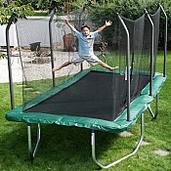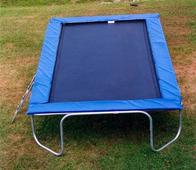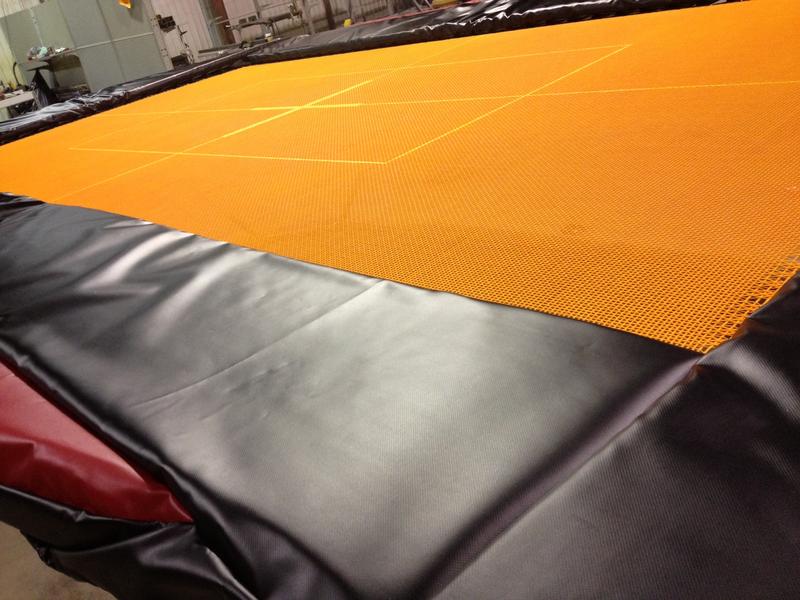There are certain features that make some rectangular trampolines more or less expensive to make than others. I am not referring to retail prices or inflated prices. I've seen more expensive trampolines cost more than I cheaper trampoline that is almost twice the quality. This was another thing that I feel I got screwed over with on my first few purchases.
The first thing I ask is who will be the user. Will their be multi users or lightweight users? A lighter to medium duty rectangle trampoline can accommodate lighter users but might need a more aero dynamic mat while a heavier person might need a heavier duty frame but prefer a less porous mat so that the extra drag will help keep them from bottoming out.
Rectangle Complaints
I get the most complaints from those who have bought models less than 12 gauge unless they are from light weight users. Most people are buying rectangle trampolines to get that higher bounce they can't get on a round trampoline.
The steal frame should also be at least 3/8" inches in diameter if they want a smooth "bottom of the bounce" point.
A weaker frame, more light weight, will not be grounded even if the gauge is less than 12. It gets tricky and without knowing someone that can figure out all the factors like this, it can be hard for a first time trampoline buyer to get the exact fit. One of the reasons why I am documenting everything I learn, even if it is not what people want to read.
With rectangular trampolines, after getting the gauge and thickness you need, the springs are the 2nd most important thing. The best springs with a cheap frame is not as good as cheap springs with a high end frame. Most of the people buying rectangle springs prefer 9 inch springs to get the high bounce but not to many free bounces. (see my page on free bounces). Extra free bounces are either preferred or disliked by most gymnasts. Kids usually don't care but for competition and extreme bouncing, it makes a night and day difference.
If I'm trying to aim for maximum free bounces Im gonna get a more softer bounce and much deeper. Also if I am looking to get the highest bounce especially for lightweight bouncers. If the goal is for working out or cardio, the opposite is usually preferred. It really all depends on how much effort you want to put into the bounce and how many free bounces you want to get out of it. I personally prefer less free bounces.
What I look for in rectangular frames:
Are the holes drilled or non drilled. That is the most important question. Even the best drilled holes can get water seeped into the frame over time, usually over time. I want to know if the frames are coated properly. Many people complain over their frames that have gotten corroded over the years, especially people in Florida. Can someone say Rust?
I want to know how much wobble from side to side it has. This has a lot to do with the gauge of the frame and thickness of the tubing. Low gauge that has a huge tubing can fool many people. A larger tubing and at least 11 gauge or stronger is preferred by most people.
If seeking maximum boost, the frame that flexes the least will take the flex out out of the frame and support heavier people with higher accelerations. A flexing frame is what takes out most of the free bounces and people always wonder what it is that makes it do that. They go from spring to spring suppliers and the problem is not the springs. It is hard to get people to understand this. I didn't at first either.
Beware: I AVOID companies that tell me that they can add an add- on support truss before they send you your trampoline. This is a huge red flag.
Note: the longer the length of a rectangle trampoline, the longer the sweet spot. Rectangle types use springs around the longer sides to give the jumper most of the bounce while the secondary springs around the short sides keep the mat taught and provide lots of extra support. Because the springs around the long sides are the primary “bounce generatorsâ€?, the sweet spot on rectangular trampolines starts very close from an end and runs the length of bed. When bouncing on a professional rectangular it's easy to first notice the bounce becomes consistent with a few feet of an end. Balance, control, responsiveness, and ease of bounce are mostly enhanced on rectangular trampolines because of the closer proximity the bouncer is to the primary springs.Â
A rectangular trampoline allows the bouncer to bounce much faster and higher in the corners than in the middle of the mat due to the construction. This can be dangerous because many children can over jump and land dangerously.
Pay attention to the max and min weight limits of the trampoline.
A strong frame makes a good quality trampoline. Frames should not flex during usage and should be durable. Rectangle professional trampolines have frames with thickness equal to 3.0mm.
With a strong frame, you can't get it cheap as their is a market price for steal. A 12 gauge will always cost more than a 13 gauge, and especially for shipping as it weighs more.
If you want to get technical, find out if the tensile strength is strong enough for the persons weight so it won't warp over time.
The most expensive rectangle trampolines have a tensile strength of at least 55,000 P.S.I. and a yield strength of 50,000 p.s.i. You want them very close together so that the frame is not too rigid but not so much that you gotta put a brick under one side because the frame is not level to the ground anymore.
It is hard to know the tensile strengths but if you know it is American steel and not mixed in with import steel, it can be more assurance you are getting the right quality. Most pure Amercian is cold formed unlike 3rd world countries that export cheaper steel. Cold steel that is the same gauge and tubing diameter of non-Cold steel is usually 20% to 30% stronger in tensile strength. Looking at the raw steel before it is coated with paint, you can tell if it is smooth US steel or the cheaper galvanized marbled looking steel that is usually on cheap models.
See the most commercial Rectangle model we have tested, 2013 model 420LB 10x17 model here.
Take the Trampoline Quiz based on your needs
Everyone is asking who really makes the best trampoline. This is how you the "pimp" out a AirArcÂ
11x17 Â trampoline. One customer put a custom painted Ross 2 string bed on it. They put a significantly reinforced frame. Â It has Olympic standard height legs, custom pads, Ross springs. Thing is so insane it's actually scary to use without foam pits on either end.
...because they all said they have the best quality and bounce
1-877-336-7890
Open from
8am till 10pm
Rectangle-Trampolines-Reviewed.com
1-877-336-7890
Open from
8am till 10pm





